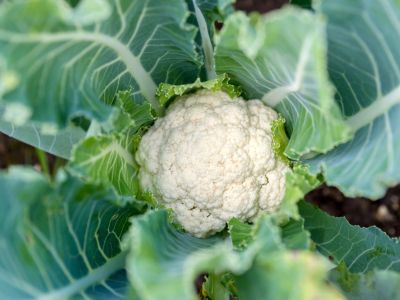What is Blanching?
For many people, particularly those familiar with the vocabulary of cooking and preserving food, blanching means plunging a fruit or vegetable into boiling water for a very short period of time to stop the maturation process, then rapidly transferring it to ice water so the item does not become fully cooked. What is blanching in vegetable gardening, however, is something entirely different. It is the technique of covering a plant or plant part to prevent the development of color. Blanching cauliflower is such a technique. That’s what gives the vegetable its creamy white color. Does cauliflower have to be blanched? Technically, no. Blanching has nothing to do with head development or nutritional content. However, if you don’t, the curds will be greenish brown rather than white and the flavor will be stronger, almost bitter. Since this is one of the more difficult garden vegetables to grow well, why wouldn’t you take the extra step of blanching cauliflower to add to the pleasure of harvesting a perfectly formed, sweet tasting head? Learning how to blanch cauliflower isn’t difficult and the results will be well worth the effort.
When and How to Blanch Cauliflower
Cauliflower needs cool temperatures, a consistent supply of moisture, and lots of fertilizer. To get white curds on many varieties, it is necessary to tie up the leaves around the developing curd. The first thing to know is when to blanch a cauliflower head. Start checking your plants about 30 days after transplanting your seedlings. The curds develop quickly and it’s that development that tells you when to blanch. A cauliflower curd about the size of a chicken egg is perfect. Smaller curds are already protected from the light by the leaves surrounding them. As they grow, they become more exposed and this is the time to begin blanching. Cauliflower curds develop rapidly into full heads so the window is small. Cauliflower is extremely susceptible to fungus, so the second condition of when to blanch a cauliflower would be the driest part of the day. You don’t want to trap moisture inside your leaf cover. How to blanch cauliflower successfully is the next step. When the curd is 2 to 3 inches (5-8 cm.) in diameter (about the size of that egg) the large outer leaves should be tied up and over the emerging curds. The easiest way to do this is to tie the leaves with rubber bands, tape, or twine. If you’re using rubber bands, be sure they are sturdy enough to contain the growing leaves and heads. The leaves should be tied loosely to give the curds plenty of room to grow. Since the curds develop at different rates, you’ll need to check your plants for several days, tying up those that are ready. If your planting is large, using a different color band or string for each day will prove useful for harvest, as those heads that were tied first will be ready for harvest first. Time from tying to harvest varies from four to five days during warm spring weather and 14 to 21 days during the cool days of autumn.
Does Cauliflower Have to be Blanched?
A small caveat to this question should be noted. There are varieties that are self-blanching. Their leaves have been bred to curl up and over the developing head and for the most part, are successful. Their downfall comes with the development of extra large curds where the leaves simply aren’t long enough to do the job. There are also more colorful varieties on the market and because they aren’t white may, at first glance, appear not to need blanching. Cauliflower such as these will still develop chlorophyll and will lose their unique color if not protected from the sun. The exception to this would be the plant known as purple cauliflower, which isn’t cauliflower at all. It’s broccoli. Knowing when to blanch a cauliflower and how to blanch cauliflower will add the perfect finishing touches to a vegetable that is often difficult to grow.
